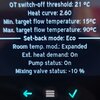- Joined
- 14 Mar 2023
- Messages
- 16
- Reaction score
- 0
- Country

Just had boiler controller upgraded:
Existing Ecotec 637 plus.
We installed a VR71 / SensoComfort VRC720f / NetSensor Gateway
Everything appears to be working. Tech support recommended system diagram 2 (we have single heating and HW circuits). We also added a second circulation pump. They recommended we use curve 2.6, and to set the mode to "expanded". Didn't use the VR11, nor 2 of the VR10 probes.
I've had a quick look and can see the timing section where we can tweak the on/off times, but is there anything else that we should be doing in terms of set up for modulation? The app isn't the greatest, but the house appears warm.
Will there be a settling in period where the system will learn how thermally insulated/uninsulated we are and make calculations accordingly etc? Is there anything else I need to be mindful of?
thx
Existing Ecotec 637 plus.
We installed a VR71 / SensoComfort VRC720f / NetSensor Gateway
Everything appears to be working. Tech support recommended system diagram 2 (we have single heating and HW circuits). We also added a second circulation pump. They recommended we use curve 2.6, and to set the mode to "expanded". Didn't use the VR11, nor 2 of the VR10 probes.
I've had a quick look and can see the timing section where we can tweak the on/off times, but is there anything else that we should be doing in terms of set up for modulation? The app isn't the greatest, but the house appears warm.
Will there be a settling in period where the system will learn how thermally insulated/uninsulated we are and make calculations accordingly etc? Is there anything else I need to be mindful of?
thx


